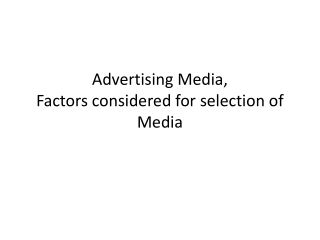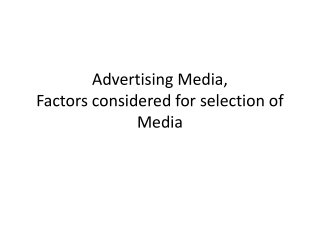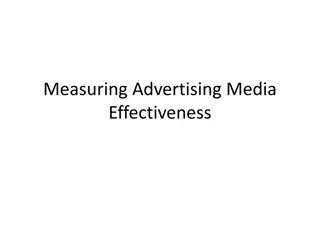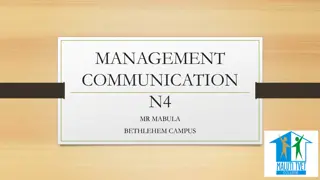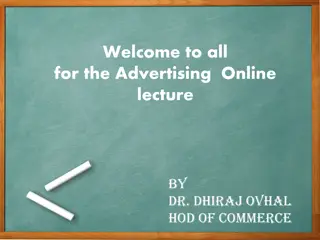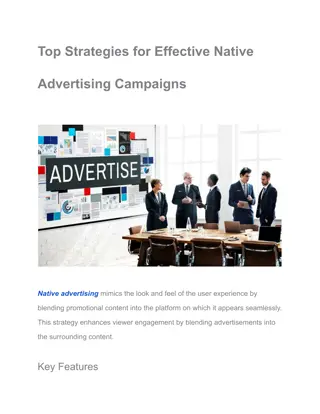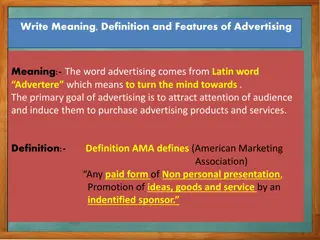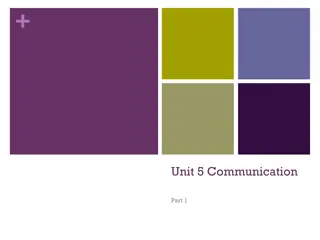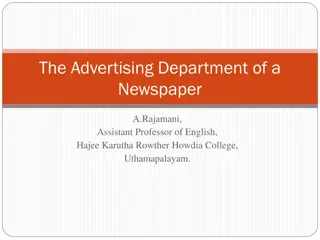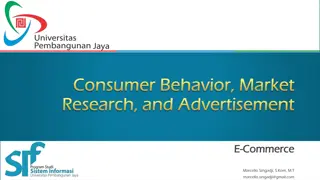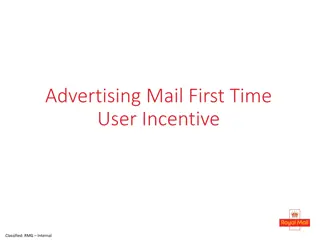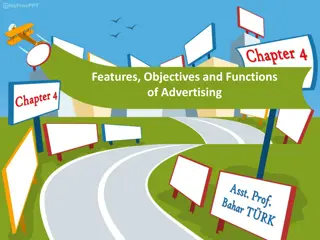Effective Communication Strategies for Advertising and Recipes
Learn about the structure and social functions of advertisement units and recipe writing. Explore how to grab attention, persuade, and target the right audience. Understand the significance of countable and uncountable nouns in language use. Discover the art of sharing recipes and communicating through different discourse genres.
Download Presentation

Please find below an Image/Link to download the presentation.
The content on the website is provided AS IS for your information and personal use only. It may not be sold, licensed, or shared on other websites without obtaining consent from the author.If you encounter any issues during the download, it is possible that the publisher has removed the file from their server.
You are allowed to download the files provided on this website for personal or commercial use, subject to the condition that they are used lawfully. All files are the property of their respective owners.
The content on the website is provided AS IS for your information and personal use only. It may not be sold, licensed, or shared on other websites without obtaining consent from the author.
E N D
Presentation Transcript
CONJUNTO 2 8 ano
Unit 1 Ad Recurrent structure Attention-grabbing headline, persuasive body copy, call- to-action. Product or service promotion, brand awareness, persuasive language. Main themes To persuade or influence the target audience to take a particular action, usually to purchase a product or service. Social function
Target audience The target audience for the product or service being advertised. Copywriters, marketers, or advertising agencies hired by the company or organization promoting the product or service. Who produces it?
Unit 1 Recipe A recipe typically includes an introduction, a list of ingredients, instructions on how to prepare the dish, and serving suggestions. Recurrent structure How to prepare a specific dish, but it may also include information about the cultural background of the dish, nutritional value, etc. Main themes
Recipes are meant to be shared, either through oral transmission or written publication. They can be used for personal cooking and meal planning, but they can be used to document traditions and heritage. Social function Individuals who are interested in cooking, from home cooks to professional chefs. They can be found in cookbooks, magazines, online recipe databases, and shared between family and friends. Target audience Who produces it? Anyone with knowledge of a particular dish, professional chefs, food bloggers, cookbook authors, or food writers.
Unit 1 Countable Nouns Countable nouns s o substantivos que podem ser contados. one carrot, two carrots, three carrots Plural: em geral, acrescentamos -s, -es, -oes ao final do substantivo. carrot carrots, peach peaches, potato potatoes Usamos a ou an antes do substantivo. Can you get an apple or a banana for me, please? Para perguntar a quantidade, usamos How many ? How many oranges did you get?
Unit 1 UncountableNouns Uncountable nouns s o substantivos que n o podem ser contados utilizando n meros. Exemplos: milk, honey, broccoli, spinach, information etc. N o h uma forma plural. N o usamos a e an antes do substantivo. This broccoli is very good! Para perguntar a quantidade, usamos How much ? How much spinach do you want?
Unit 1 Quantifiers Some and Any Quantifiers s o palavras ou express es que usamos antes de um substantivo para indicar quantidade. Some e any s o dois quantifiers muito usados. Some Usamos para nos referir a uma quantidade n o exata equivale a algum(ns) , alguma(s) em frases afirmativas; em perguntas; quando oferecemos ou pedimos algo; com countable e uncountable nouns. This plant needs some water.



